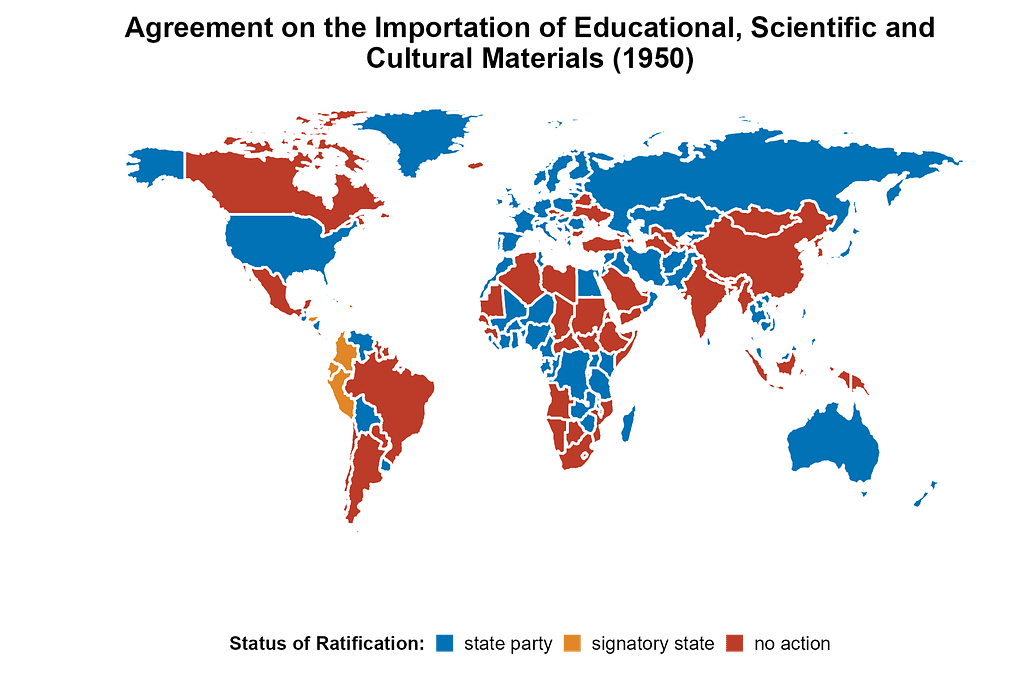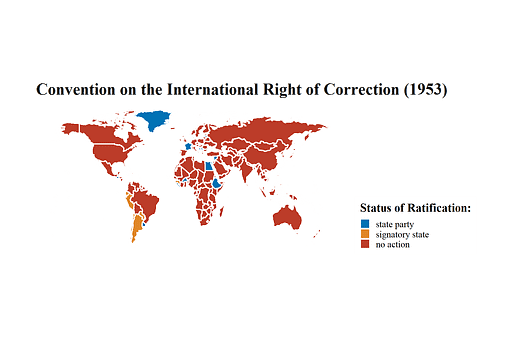ASHLEY KIBEL & DANIELLA ROSERO
Globalization has transformed the international economy into a series of supply chains that are so interconnected that institutions such as the United Nations (UN) have taken it upon themselves to facilitate the trade of intellectual property (IP) through treaties. In this post, we examine the 1950 Agreement on the Importation of Educational, Scientific and Cultural Materials, which is also known as the Florence Agreement and administered by the United Nations Educational, Scientific and Cultural Organization (UNESCO). We also evaluate this treaty’s contributions to the promotion of UNESCO’s values and interests.
The Agreement mandates and promotes trade of such education, scientific, and cultural materials for educational purposes without the limitation of additional taxes or restrictions other than the value of the products. It guarantees the free flow of information and ideas to better the understanding of different cultures and to promote innovation. This treaty is primarily a trade agreement, linking human rights to questions related to intellectual property (IP) rights.
We used the United Nations Treaty Collection’s website to measure the agreement’s current ratification status. We classified UN member states into three categories. States that have not signed or ratified the agreement are labeled as states that have taken “no action.” States that have signed the instrument, but not ratified it, are considered “signatory states”, while a state that has ratified the treaty is cataloged as a “state party.”

The map shows that the instrument’s ratification status varies widely across the world’s regions. For the most part, high-income, Western states have been more likely to ratify this instrument than lower-income states in the Global South. This suggests that they are more willing to license their IP than less developed countries because they afford to lower the cost and provide resources without losing significant profit. For instance, Ecuador, Colombia, and Peru have signed but not ratified the agreement. The reasoning behind this is possibly attributed to the countries’ cultural property laws.
While many countries have ratified the agreement, some have not accepted all of its provisions. For example, Germany, one of the world’s leading economies, clarified that granting customs exemptions aimed to facilitate the free exchange of ideas and knowledge, not primarily for financial gain. Another good example is Kenya, which has made it clear that antiques, considered to be more than 100 years old, are free of duty as long as they are classified as “works of art”.
In the discussion of the individual “no action” countries, Julian Behrstock’s “No Taxes on the Printed Word” expresses the reasoning behind these countries’ decisions to not sign and ratify the treaty. Behrstock states that India, which is one of the “no action” states, has decided to not ratify the treaty because the country believes that the sale of Indian books should be emphasized before their books can be sold abroad. In other words, India’s lack of action demonstrates the states’ desire to prioritize the sale of domestic intellectual property before any negotiations can take place with the West. Essentially, each country has concerns over the specific language used in the treaty and how it will affect the dissemination of their intellectual property. Similar to India, the United States was fearful of the Universal Copyright Convention and the Florence Agreement for its potential block of British books because of copyright and customs. However, this issue was resolved and the United States became a state party in 1966.
Although the Florence Agreement does not have a consensus from all states, it is evident that the states who have yet to sign the treaty have particular reservations about its ratification. The geographical location of these countries does not quite translate into their overall acceptance and ratification of the treaty, but rather the specific laws and agreements specific to their countries, such as cultural preservation and copyright influence their decision to ratify.UNESCO’s efforts to make scientific, educational, and cultural media accessible through the elimination of tariffs demonstrates the organization’s goals to promote interconnection between different parts of the world, spreading globalization during the 1950s and onward. Specifically in the case of state parties, the treaty ensures the free flow of information concerning science, education, and cultural material.
Overall, the Florence Agreement has become a foundational document for the discussion of the ownership of intellectual property rights and whether pieces of media can be shared without the presence of tariffs across borders.
Want to learn more about this legal instrument?
Data on this convention’s ratification status is available on the World Politics Data Lab’s GitHub page. The most recent dataset was uploaded to the repository on October 1, 2023.
For more information on the convention’s history and its current application, please refer to the following academic writings:
Behrstock, J. (1983). No Taxes on the Printed Word. Journal of Reading, 26(5), 412–415.
Symonides, J. and Volodi, V. (1999). UNESCO and Human Rights: Standard-Setting Instruments, 2nd edition (Paris, UNESCO).
About the authors:
Ashley Kibel is a junior, majoring in International Relations and minors in German and Economics at Drew University.
Daniella Rosero is a junior, majoring in Political Science and Spanish at Drew University.
Editor’s note: This post is part of a long-term project. Students enrolled in Drew University’s Semester on the United Nations, Principles in International Law, and International Human Rights have been and will be collecting data on the ratification status of treaties deposited in the United Nations Treaty Collection. For more information on this project and its learning goals, click here.


